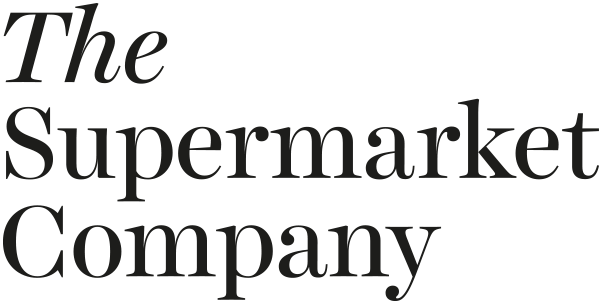More than 15 Minutes with Nicola Anthony and Daniela Beltrani

“More than 15 minutes” takes a current approach on Warhol’s famous expression “In the future, everyone will be world-famous for 15 minutes”. In social media’s world of instant fame and celebrity, this phrase has never been as omnipresent as it is today. “More than 15 minutes” is thus about slowing down, taking time to appreciate the present and discover the real personalities around us.
Nicola Anthony is a professional artist based in Singapore and working internationally. She studied at the University of the Arts London and Loughborough University. Daniela Beltrani is the curator of her exhibition in SPRMRKT.
1) Nicola, let’s start with what you’re going to do at the final performance at SPRMRKT on 27 Nov.
NA: For the final performance I will be transposing more secrets to the window installation to give an airing to the confessions gathered during the final days of Secret Ingredient. I will be spending time focusing on the performative act of writing, sometimes writing in mirror image as I stand on the other side of the glass, other times writing upside down. Through the process of this exhibition I have become very used to writing on a different plane to what is usual.
2) The entire exhibition has been captivating from collecting confessions before the opening reception of Secret Ingredient to your collaborative performance acts with curator, Daniela. Both of you created quite a spectacle two Sundays ago. Daniela, was this the first time you performed a piece in a public place? How long were you seated outside SPRMRKT? Nicola, could you describe your first experience or how you felt?
DB: Thank you. We are glad about the positive response. No, I have performed in many public spaces in Singapore and abroad, that is an essential part of my performance practice (next week I’ll be in Melaka and perform in an abandoned/deconsecrated church). Anonymous words was first performed in June 2013 in a house destined to be torn down (that’s where I met Nicola! ?). We were @ SPRMRKT for only 45 minutes because of time restraints, but we could easily do as much as we did at AAF (105 minutes) and I dare say even more. Nicola agreed with me. We intend to continue the series…
NA: Bringing Anonymous Secrets to the public that weekend was a really intense and wonderful experience. By eliminating our other senses, we became hypersensitive to the minute sounds of people nearby, watching, breathing, considering if they should join in. And when someone steps close to whisper to us, the sense of touch also comes into play as hands are held and secrets are shared.
I have been collecting words through the Word Collection Project for the last ten years, which has been a fascinating journey into the human mind. It has been an exciting evolution of this ongoing practice to collect confessions for SECRET INGREDIENT. Through working together, the opportunity to bring together our two projects arose and so even though the exhibition is coming to an end soon, it has also been the start of an ongoing collaborative performance series that I am really looking forward to continuing!
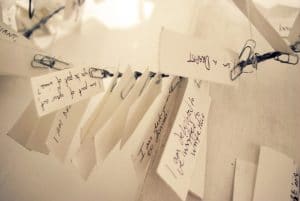
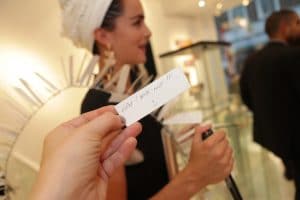
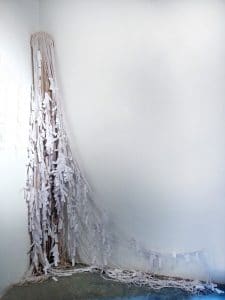
DB: YES! The main idea is tokeep eyes and mouth closed, s that our ego does not interfere in the process of unburdening the sitter. How many times we offered solutions to friends who perhaps only needed to be heard and not judged? So words spoken in intimacy by a stranger become words written by us, thus collected and acknowledged.
3) Does the idea of collaborating then become a source of inspiration or just a tool to help you express your ideas? What was it like working with one another?
NA: It is both. I think new ideas such as performance and the Artist Multiple grew organically because of our collaboration as artist and curator, and it is creatively expanded by our working relationship to encapsulate more. Collaboration can help you push boundaries. For example I am on new territory with performance, and Daniela is pushing her own boundaries with more physical making processes involving in creating ‘Box of Secrets’.
[youtube https://www.youtube.com/watch?v=OKu38HWUodI&w=420&h=315]
For the actual roles as artist and curator, yes we each have our own distinct areas here, but I also saw my work take influence from our dialogue, and simultaenously her curation was shaped in part through my use of sea, waves, organic lines – resulting in the flowing hang of the artworks as they undulate across the space.
4) So some of the best ideas evolve organically between artist and curator. What other successful collaborations have u done before? Would u be able to share some of the less successful ones too or ones where u felt u needed more control as an artist ?
NA: I have tried many kinds. Most recently I created a sculpture which was also produced through a collaborative process with the community – working with over 5000 local children for them all to become part of a light sculpture called Ouroboros (Marina Bay, Singapore, 2015). I know they inspired me and I think I inspired them too!
I have worked on projects with many other artists through our Edible Art Movement projects. In this I was guiding the overall concept and inviting other artists to bring their creativity into the installation. I have also collaborated directly with visual artists which brings the partnership right into the heart of the creative and visual process.
DB: For me it was not so much as pushing boundaries as blurring them to the point that the experience is no longer about art and ego but life and humanity and spills over those boundaries altogether. It has also allowed me to appreciate Nicola more not only as a sensitive artist but a sensitive human being. The quiet and meditative approach of the stamping has been a grounding experience; I only wished that I had done it more in her presence whilst she was making her mark on the boxes. As for the performance it has opened the door to standalone series which branches/ complements her research into words and my practice in company of a visual artist (since often my performance art practice can be quite solitary.)
In terms of curator-artist, I enjoy the organic and intense relationship particularly when it entails the artist making new works. The exchange was extremely healthy and even and I felt we both learnt something. I have had one unsuccessful experience of working with an artist whose ego was often in the way and despite the exhibition not showing signs of strains, on a human level it felt like a very contracting experience.
5) Thanks for sharing Daniela. Secret Ingredient was certainly a hit with our audience. Coming back to the exhibition at SPRMRKT. Nicola, you created a site specific installation, taking references from the historic Telok Ayer neighbourhood, such as rice and joss sticks to form the basis of your work on sewing hoops. We’re curious to see where Secret Ingredient would appear next. Are there plans to recreate Secret Ingredient elsewhere?
NA: In terms of the artworks, many of them have sold, so the exhibition complete was truly a one-time event. My remaining artworks will still be available for purchase and may be continuing their journeys into future exhibitions too.
Meanwhile the secrets themselves seem rather too precious to replicate on another window. I feel they were entrusted to me specifically for this exhibition. I will be archiving them on my website so they are still available for reference, and perhaps this archive would work well as a physically printed archive or publication in future to add to the outcomes of Secret Ingredient.
6) You were also found collecting confessions at the Affordable Art Fair this year and similarly carefully executed them on one of the glass windows at the main entrance. You even attracted some attention where one passerby commented that your work reminded her of Yoko Ono. Was Wish Tree a source of inspiration to your work at all? Where do other sources of inspiration come from?
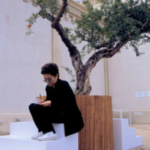
NA: I love the idea of wish trees. Coincidentally there is one outside the 170 year old Singapore Yu Huang Gong temple on Telok Ayer, which I added some wishes to during my walks around the area whilst making the Atlas Series artworks.
Yoko Ono’s work often has a poetic side, so her use of words and means of engaging the public has often inspired and influenced me. I think a key conceptual difference with the confessions is that instead of promising the wishes would be unread and then buried, I am promising the confessions will be ‘aired’, given a chance to be shared with others, and perhaps leading to a sense catharsis or at least a chance for the individual to address them. In the end quite a few confessions were indeed confessed wishes, but many others were looking to the past rather than looking to the future.
7) Were there any confessed wishes you might like to share with us which you thought were beautiful? Daniela, did u give one?
NA: (with reference to the confessions collected at SPRMRKT) Oh, so many amazing ones! I was genuinely moved, the whole spectrum of human emotion is there. Some were quite poetic and reflective – “True self awareness is the understanding that we are all characters in someone else’s dream”; some show a wonderful moment of goodness in life – “I have found the one that completes me. Thank you, thank you, thank you.”; while others were poignantly beautiful in their honesty and the depth of what they revealed – “I’m sorry and I miss you everyday. I do love you, my aborted child”.
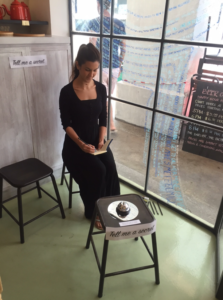
Some of my favorites were from children who may not have so many dark secrets yet, what a wonderful thing to have a confession of “I love you mummy”. In the end we can see this very essential human element of family filtering through to adult confessions in both positive and negative ways: “I was lied to, out of love, and out of other people’s human weaknesses, during my upbringing…” or “Mum I miss you everyday, you were my best friend and I never knew how truly unconditional your love was until I had my own child. I wish you could meet her now.”
DB: (with reference to the performance act for Anonymous Secrets at SPRMRKT) For me it was the children’s ones that struck me and belied timid or unspoken and innocent desires: “I want a kitten” or “l never kissed a girl” but l admit that the openness of the space only offered a short and language-based sharing. People never sat and only shared in passing, standing. Unlike what l experienced in 2013, where the privacy of the space allowed the sitters not only to verbalise (one even spoke to me in Spanish) but also to cry, to touch me, to hug me, to hold hands with me. Then, it felt a more complex engagement than words, which is why I often rely to silent performances so that I can encourage the audience to abandon intellect and words and retrieve the language of the soul more accurate and authentic than words could ever be…
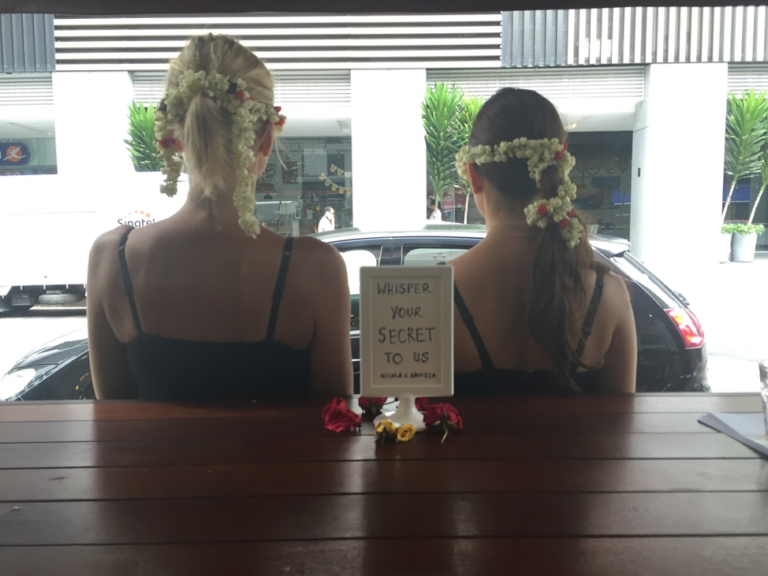
8) Do you cook?
NA: Yes! I love to cook and have lots of Asian recipes passed down from my father’s side, and English recipes passed on from my mother’s side.
9) Would u share any one of them with us?
NA: My family is very ‘fusion’ in a rather unusual way, and I am constantly finding things that have been brought over from Asia and then anglicised, for example when my family first arrived in the uk Chinese style noodles were not possible to buy, so I have a family recipe for a curry with a fresh coconuty/tamarind/limeleaf flavour but served over spaghetti – obviously very wrong but I wouldn’t eat it any other way!
But as we are in Asia now I will share a European tradition we have every Christmas. In the 16th to 19th century, salt beef was very popular in the English navy as a way of preserving food. My family doesn’t eat beef so each year we buy a big joint of lamb, squeeze a massive sack of lemons, add a lot of salt and preserve the raw meat in it, before roasting it after a few days.
10) And since we’re on the topic of food, there seems to be recurring associations to food in your work and you even founded an influential club called The Edible Art Movement. What does food mean to you?
NA: Ironically while you would think this comes from my English relatives, this recipe comes from the Anglo-Indian side of my family, where the British presence in India many years ago had an influence on the cooking traditions. So food and family and history are very interlinked for me. For example my Nan’s Bread and Butter Pudding, the recipe for which originated in London during the Second World War. Food is really a big influence in my life – and conceptually it links with history, geography, environment, science, biology, personal memory, cultural memory, the senses… It’s a very rich subject to devour. This is why myself and my fellow co-founders began to develop creative art events as the Edible Art Movement.
11) We hope to try that curry spaghetti and bread n butter pudding some day. Any final thoughts about your show at SPRMRKT?
NA: It has been a fantastic time. An experience where the public really responded in a heartfelt way, surprising and moving me with their confessions and secrets, which shaped the artworks I produced. The SPRMRKT team has been wonderful – embracing some very experimental ideas, enabling a platform for live art, installation on the window, performance art, the launch of our Artists’ Multiple, and audience interaction – all within one exhibition! And of course it has been a fantastic period of development for me, especially with Daniela’s valuable guidance and inspiration as both curator and collaborator.
So from me, just a big thank you to everyone who made this possible, to the public for their response and support, and to all the new collectors who purchased artworks.
